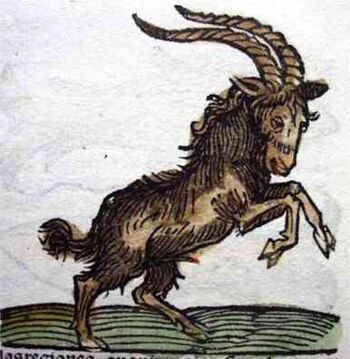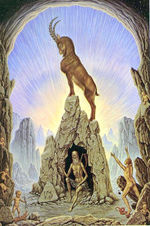Capricorn

Symbol: 
Ruling Planet: Saturn
Sun in Capricorn: from about the 22nd December to the 19th January
Season: Winter solstice, nature's withdrawal to its lowest point, hardship and cold
Culture: Christmas, the Mithras Cult of the invincible Sun, rebirth of light, hoar frost.
Physical Body: Skeletal frame and knees
Star constellation: Capricornus
Mythology of the constellation
The constellation shows a creature with the head and front legs of a goat and the tail of a fish. The Babylonians were already aware of this symbolism which unites earth and water, the material and the emotional. C.G. Jung writes "The Sun climbs like a goat up the highest mountain and is like a fish in the depths of the ocean". Sometimes the goat is associated with the unicorn, an ancient symbol for the higher worlds to which the Capricorn aspires to climb.
In ancient mythology, Capricorn is related to the god Pan. He is the son of Hermes and is one of the Satyrs, human-like creatures with the horns and legs of a ram and a horses tail. He was raised by nymphs after his mother, disgusted by his appearance, abandoned him. Pan tended sheep and goats and was a talented musician. His libidinous nature also drove him to go after the nymphs who usually fled in panic at the sight of him. When the nymph Syrinx was no longer able to flee him she begged to be turned into reed which Pan used to create the well-known Pan flute. At one time Pan himself was fleeing from the monster Typhon and tried but failed to turn himself into a fish. However, he supported Zeus in his battle with Typhon, and in thanks Zeus immortalised him by transforming him into a star constellation.
Liz Greene[2]: The goat is a deeply paradoxical image in myth. A goat called Amalthea suckled the infant Zeus, and when he became king of the gods he placed her horn - the Cornucopia - in the heavens as an image of the earth's abundance.
Goats were also symbols of licentiousness, and the great goat god Pan, with his wild train of satyrs, personified the uncontrolled life-force expressed as human lust. As pagan appreciation of nature gave way to Christian devaluing of instinctual life, the lascivious goat of Pan became the scapegoat, the animal embodiment of human failure and imperfection.
Saturn, planetary ruler of Capricorn, was, like Amalthea, a personification of the riches of the earth, and in Greco-Roman myth he presided over the Golden Age, when human beings lived in harmony with natural law. Yet Saturn was also the god of time who set the limits of mortal life, and thus embodied not only the abundance of nature but also its grim mortality.
The sign of Capricorn begins at the winter solstice, when the nights are longest and the sense of hope is at its lowest ebb. At this time of darkness and despair the mythic Sun god was reborn each year. The profound symbolism of light reborn from the darkness may be seen not only in Christian imagery, but also in the figures of Mithras and Sol Invictus, who shared a birthday with Jesus and were, like him, dominant in the religious life of the late Roman Empire.
Thus the mythic backdrop of Capricorn the Goat expresses many levels of meaning, from the sensuous abundance of the earth to the inevitability of death, and the hope of redemption that is born when the sense of mortality is most acute. Capricorn is a sign of both darkness and light, structure and abandonment. It is not surprising that those in whom the sign is prominent often have such difficulty in understanding the apparently contradictory facets of their own nature.
Interpretation
Capricorn is the tenth sign of the zodiac. It is concerned with the social sphere. The individual is part of society and must adhere to certain rules - while at the same time acting responsibly.
People born with an emphasis on this sign are very good at understanding the duties that come with being part of society: They generally adhere to the existing rules and regulations and they crave social recognition for the work they do for society. They are able to take on responsibilities, concentrate on what is necessary and essential and work hard. They persevere and are very patient because they are able to concentrate on long-term goals and greater social roles. They are dedicated, hard working and able to put up with long periods without success in order to finally achieve what they long for. They are disciplined and want to get to the heart of any matter and they generally contribute to upholding existing social structures and order.
Capricorns are sometimes in danger of sacrificing their ethical principles in order to achieve their goals, and their motto is sometimes: "The ends justify the means". Their sense of duty can also lead them to neglect other areas of their lives which can sometimes cause them to develop a dour and hard attitude to life.
One of the shadow aspects of Capricorn is its tendency to worship rules and regulations which can cause them to overlook alternative individual solutions to social problems.
And finally, Capricorns tend to revere tradition and try to conserve those things which they feel have stood the test of time.
Any planets or axes in the sign of Capricorn exhibit the Capricornian qualities of being serious, persevering and tough.
Both Capricorn and its opposite sign of Cancer are orientated towards the past: In Cancer's case this is the family history, whereas Capricorn is interested in the existing social structures. Capricorn, like the other earth signs Taurus and Virgo, is pragmatic: Taurus is pragmatic in the service of comfort, Virgo has a pragmatic attitude towards everyday life and Capricorn uses pragmatism in order to advance its social standing. Capricorn can learn important lessons from the two signs that stand in archetypal square to it: From Aries the art of being spontaneous and from Libra the appreciation of beauty.
Saturn is the ruler of Capricorn. Mars is exalted in Capricorn, the Moon in detriment and Jupiter in fall.
See also
Weblinks
- Capricorn the Goatfish (Deborah Houlding, Skyscript)
- The Zodiac Suite: "Capricorn" by Rebecca Tripp (youTube)
- Sound of zodiac - Capricorn (youTube)
